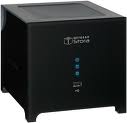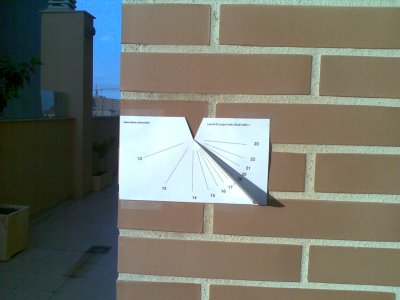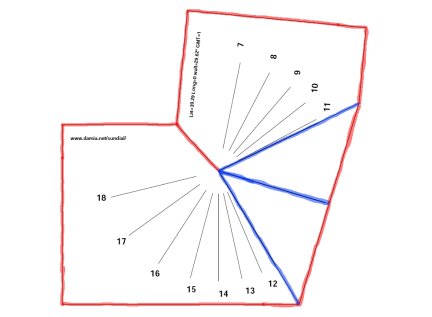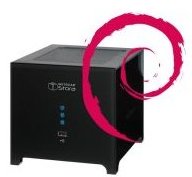As a birthday present my wife give me a SOHO Nas Netgear Stora, the device is very affordable, and have good hardware features, one gigabit Ehernet card, 2 SATA bays (for RAID 1), and 1 USB external port.

The default factory software is very impressive, but can tell about it too bad and too good things, It have amazing features, some arbitrary limits and some scary features with serious privacy and loos of control concerns.
The main arbitrary limits are:
-RAID 1 as only posible setup of disk, if you want to have two disk wituot mirror you can’t.
-Limit the number of user to 3 (this limit and others must be eliminated paying a subscription!! 🙁 ).
-Lacks some services and protocols like rsync, nfs, or console access.
The device is capable of serving your content on local LAN with SAMBA (windows shares), and is capable to serve the content with via web with http, you can access your content from your LAN, and even from any point of Internet, you can access your photos, your videos, your documents from any point of Internet, the device is able to modify your router setup, (via Upnp), and give access to external access. It have amazing features, via web you can listen your MP3, see your videos, amazing for a non expert user.
The concerns came when you realize that to access as a administrator of your device, you have to access throught the Netgear portal, your NAS is not administrable without Internet acess (and Netgear server availability), once the NAs is setup it can server contents on LAN, buy you can’t do any administration task witout Internet. What happen if Netgear have availability problems? And you Internet provider avalability? And What happen if Netgear have security problems? All your private files would be available for everyone?
With that drawbacks, I was seriosly thinking about returning the device, but I thought, What if could run a fully controled Linux version where we can add all the features we need, less commercial and user-friendly but with all the control?? Thinking about the same I have with the linksys router, Siemens Gigaset, etc.
Due to the device is new in the market, there are still no alternative firmwares, the developer community (hacker community as a good term), still have no time to develop, buy they discover they could obtain root, and in short term It will be possible to install all you wish, It will be possible to install Debian, Then I have decide to wait to that 🙂
If you are interested on developments to free the device, visit http://hardwarehackersunite.com/ you will find people working on that, There will be advances soon..
Some info obtained from the shell of the device:
# dmesg
Linux version 2.6.22.18-Netgear (tgk@fc10-64bit) (gcc version 4.2.1) #4 Thu Sep 3 13:29:25 EDT 2009
CPU: ARM926EJ-S [56251311] revision 1 (ARMv5TE), cr=00053977
Machine: Feroceon-KW
Using UBoot passing parameters structure
Memory policy: ECC disabled, Data cache writeback
On node 0 totalpages: 32768
DMA zone: 256 pages used for memmap
DMA zone: 0 pages reserved
DMA zone: 32512 pages, LIFO batch:7
Normal zone: 0 pages used for memmap
CPU0: D VIVT write-back cache
CPU0: I cache: 16384 bytes, associativity 4, 32 byte lines, 128 sets
CPU0: D cache: 16384 bytes, associativity 4, 32 byte lines, 128 sets
Built 1 zonelists. Total pages: 32512
Kernel command line: console=ttyS0,115200 ubi.mtd=2,2048 root=ubi0:rootfs rootfstype=ubifs init=/linuxrc
PID hash table entries: 512 (order: 9, 2048 bytes)
Console: colour dummy device 80×30
Dentry cache hash table entries: 16384 (order: 4, 65536 bytes)
Inode-cache hash table entries: 8192 (order: 3, 32768 bytes)
Memory: 64MB 64MB 0MB 0MB = 128MB total
Memory: 125312KB available (4204K code, 272K data, 112K init)
Calibrating delay loop… 992.87 BogoMIPS (lpj=4964352)
Mount-cache hash table entries: 512
CPU: Testing write buffer coherency: ok
NET: Registered protocol family 16
CPU Interface
————-
SDRAM_CS0 ….base 00000000, size 64MB
SDRAM_CS1 ….base 04000000, size 64MB
SDRAM_CS2 ….disable
SDRAM_CS3 ….disable
PEX0_MEM ….base e8000000, size 128MB
PEX0_IO ….base f2000000, size 1MB
INTER_REGS ….base f1000000, size 1MB
NFLASH_CS ….base fa000000, size 2MB
SPI_CS ….base f4000000, size 16MB
BOOT_ROM_CS ….no such
DEV_BOOTCS ….no such
CRYPT_ENG ….base f0000000, size 2MB
Marvell Development Board (LSP Version KW_LSP_4.2.7_patch21)– RD-88F6281A Soc: 88F6281 A0 LE
Detected Tclk 200000000 and SysClk 333333333
MV Buttons Device Load
Marvell USB EHCI Host controller #0: c05d4600
PEX0 interface detected no Link.
PCI: bus0: Fast back to back transfers enabled
SCSI subsystem initialized
usbcore: registered new interface driver usbfs
usbcore: registered new interface driver hub
usbcore: registered new device driver usb
NET: Registered protocol family 2
Time: kw_clocksource clocksource has been installed.
IP route cache hash table entries: 1024 (order: 0, 4096 bytes)
TCP established hash table entries: 4096 (order: 3, 32768 bytes)
TCP bind hash table entries: 4096 (order: 2, 16384 bytes)
TCP: Hash tables configured (established 4096 bind 4096)
TCP reno registered
RTC has been updated!!!
RTC registered
Use the XOR engines (acceleration) for enhancing the following functions:
o RAID 5 Xor calculation
o kernel memcpy
o kenrel memzero
Number of XOR engines to use: 4
cesadev_init(c000c8e4)
mvCesaInit: sessions=640, queue=64, pSram=f0000000
MV Buttons Driver Load
JFFS2 version 2.2. (NAND) © 2001-2006 Red Hat, Inc.
io scheduler noop registered
io scheduler anticipatory registered (default)
Serial: 8250/16550 driver $Revision: 1.90 $ 4 ports, IRQ sharing disabled
serial8250.0: ttyS0 at MMIO 0xf1012000 (irq = 33) is a 16550A
serial8250.0: ttyS1 at MMIO 0xf1012100 (irq = 34) is a 16550A
loop: module loaded
Loading Marvell Ethernet Driver:
o Cached descriptors in DRAM
o DRAM SW cache-coherency
o Multi RX Queue support – 4 RX queues
o Multi TX Queue support – 2 TX Queues
o TCP segmentation offload enabled
o Receive checksum offload enabled
o Transmit checksum offload enabled
o Network Fast Processing (Routing) supported
o Network Fast Processing (NAT) supported
o Driver ERROR statistics enabled
o Driver INFO statistics enabled
o Proc tool API enabled
o Gateway support enabled
o Using Marvell Header Mode
o L2 IGMP support
o Rx descripors: q0=128 q1=128 q2=128 q3=128
o Tx descripors: q0=532 q1=532
o Loading network interface(s):
o eth0, ifindex = 1, GbE port = 0
o eth1, ifindex = 2, GbE port = 1
mvFpRuleDb (c7fd0000): 1024 entries, 4096 bytes
Intel(R) PRO/1000 Network Driver – version 7.3.20-k2-NAPI
Copyright (c) 1999-2006 Intel Corporation.
e100: Intel(R) PRO/100 Network Driver, 3.5.17-k4-NAPI
e100: Copyright(c) 1999-2006 Intel Corporation
Integrated Sata device found
scsi0 : Marvell SCSI to SATA adapter
scsi1 : Marvell SCSI to SATA adapter
scsi 0:0:0:0: Direct-Access Seagate ST31000528AS CC38 PQ: 0 ANSI: 5
sd 0:0:0:0: [sda] 1953525168 512-byte hardware sectors (1000205 MB)
sd 0:0:0:0: [sda] Write Protect is off
sd 0:0:0:0: [sda] Mode Sense: 23 00 10 00
sd 0:0:0:0: [sda] Write cache: enabled, read cache: enabled, supports DPO and FUA
sd 0:0:0:0: [sda] 1953525168 512-byte hardware sectors (1000205 MB)
sd 0:0:0:0: [sda] Write Protect is off
sd 0:0:0:0: [sda] Mode Sense: 23 00 10 00
sd 0:0:0:0: [sda] Write cache: enabled, read cache: enabled, supports DPO and FUA
sda: sda1
sd 0:0:0:0: [sda] Attached SCSI disk
sd 0:0:0:0: Attached scsi generic sg0 type 0
NFTL driver: nftlcore.c $Revision: 1.98 $, nftlmount.c $Revision: 1.41 $
NAND device: Manufacturer ID: 0xec, Chip ID: 0xda (Samsung NAND 256MiB 3,3V 8-bit)
Scanning device for bad blocks
Bad eraseblock 166 at 0x014c0000
Bad eraseblock 807 at 0x064e0000
Bad eraseblock 1190 at 0x094c0000
Using static partition definition
Creating 3 MTD partitions on “nand_mtd”:
0x00000000-0x00100000 : “u-boot”
0x00100000-0x00700000 : “uImage”
0x00700000-0x10000000 : “root”
UBI: attaching mtd2 to ubi0
UBI: physical eraseblock size: 131072 bytes (128 KiB)
UBI: logical eraseblock size: 126976 bytes
UBI: smallest flash I/O unit: 2048
UBI: sub-page size: 512
UBI: VID header offset: 2048 (aligned 2048)
UBI: data offset: 4096
UBI: attached mtd2 to ubi0
UBI: MTD device name: “root”
UBI: MTD device size: 249 MiB
UBI: number of good PEBs: 1989
UBI: number of bad PEBs: 3
UBI: max. allowed volumes: 128
UBI: wear-leveling threshold: 4096
UBI: number of internal volumes: 1
UBI: number of user volumes: 1
UBI: available PEBs: 0
UBI: total number of reserved PEBs: 1989
UBI: number of PEBs reserved for bad PEB handling: 19
UBI: max/mean erase counter: 1/0
UBI: background thread “ubi_bgt0d” started, PID 295
ehci_marvell ehci_marvell.70059: Marvell Orion EHCI
ehci_marvell ehci_marvell.70059: new USB bus registered, assigned bus number 1
ehci_marvell ehci_marvell.70059: irq 19, io base 0xf1050100
ehci_marvell ehci_marvell.70059: USB 2.0 started, EHCI 1.00, driver 10 Dec 2004
usb usb1: configuration #1 chosen from 1 choice
hub 1-0:1.0: USB hub found
hub 1-0:1.0: 1 port detected
ohci_hcd: 2006 August 04 USB 1.1 ‘Open’ Host Controller (OHCI) Driver
USB Universal Host Controller Interface driver v3.0
usbcore: registered new interface driver usblp
drivers/usb/class/usblp.c: v0.13: USB Printer Device Class driver
Initializing USB Mass Storage driver…
usbcore: registered new interface driver usb-storage
USB Mass Storage support registered.
mice: PS/2 mouse device common for all mice
i2c /dev entries driver
Linux telephony interface: v1.00
md: linear personality registered for level -1
md: raid0 personality registered for level 0
md: raid1 personality registered for level 1
raid6: int32x1 81 MB/s
raid6: int32x2 95 MB/s
raid6: int32x4 102 MB/s
raid6: int32x8 92 MB/s
raid6: using algorithm int32x4 (102 MB/s)
md: raid6 personality registered for level 6
md: raid5 personality registered for level 5
md: raid4 personality registered for level 4
raid5: measuring checksumming speed
arm4regs : 903.600 MB/sec
8regs : 629.200 MB/sec
32regs : 750.000 MB/sec
raid5: using function: arm4regs (903.600 MB/sec)
device-mapper: ioctl: 4.11.0-ioctl (2006-10-12) initialised: dm-devel@redhat.com
dm_crypt using the OCF package.
sdhci: Secure Digital Host Controller Interface driver
sdhci: Copyright(c) Pierre Ossman
usbcore: registered new interface driver usbhid
drivers/hid/usbhid/hid-core.c: v2.6:USB HID core driver
Advanced Linux Sound Architecture Driver Version 1.0.14 (Thu May 31 09:03:25 2007 UTC).
ALSA device list:
#0: Marvell mv88fx_snd ALSA driver
Netfilter messages via NETLINK v0.30.
nf_conntrack version 0.5.0 (1024 buckets, 8192 max)
mvFpNatDb (c7e72000): 1024 entries, 4096 bytes
ip_tables: (C) 2000-2006 Netfilter Core Team
TCP cubic registered
NET: Registered protocol family 1
NET: Registered protocol family 17
NFP (fdb) init 256 entries, 1024 bytes
Bridge firewalling registered
802.1Q VLAN Support v1.8 Ben Greear
All bugs added by David S. Miller
md: Autodetecting RAID arrays.
md: autorun …
md: considering sda1 …
md: adding sda1 …
md: created md0
md: bind
md: running:
raid1: raid set md0 active with 1 out of 2 mirrors
md: … autorun DONE.
UBIFS: mounted UBI device 0, volume 0, name “rootfs”
UBIFS: file system size: 239857664 bytes (234236 KiB, 228 MiB, 1889 LEBs)
UBIFS: journal size: 9023488 bytes (8812 KiB, 8 MiB, 72 LEBs)
UBIFS: media format: 4 (latest is 4)
UBIFS: default compressor: zlib
UBIFS: reserved for root: 0 bytes (0 KiB)
VFS: Mounted root (ubifs filesystem).
Freeing init memory: 112K
Failed to execute /linuxrc. Attempting defaults…
mvsdmmc: irq =28 start f1090000
mvsdmmc: irq_detect=92
SGI XFS with ACLs, large block numbers, no debug enabled
XFS mounting filesystem md0
Starting XFS recovery on filesystem: md0 (logdev: internal)
Ending XFS recovery on filesystem: md0 (logdev: internal)
eth0: link down
eth0: started
eth0: link up, full duplex, speed 100 Mbps
tun: Universal TUN/TAP device driver, 1.6
tun: (C) 1999-2004 Max Krasnyansky
Adding 511992k swap on /home/.swapfile. Priority:-1 extents:1 across:511992k
# cat /proc/cpuinfo
Processor : ARM926EJ-S rev 1 (v5l)
BogoMIPS : 992.87
Features : swp half thumb fastmult edsp
CPU implementer : 0x56
CPU architecture: 5TE
CPU variant : 0x2
CPU part : 0x131
CPU revision : 1
Cache type : write-back
Cache clean : cp15 c7 ops
Cache lockdown : format C
Cache format : Harvard
I size : 16384
I assoc : 4
I line length : 32
I sets : 128
D size : 16384
D assoc : 4
D line length : 32
D sets : 128
Hardware : Feroceon-KW
Revision : 0000
Serial : 0000000000000000
# cat meminfo
MemTotal: 125428 kB
MemFree: 2268 kB
Buffers: 0 kB
Cached: 79388 kB
SwapCached: 16 kB
Active: 61464 kB
Inactive: 35612 kB
SwapTotal: 511992 kB
SwapFree: 510876 kB
Dirty: 0 kB
Writeback: 0 kB
AnonPages: 17688 kB
Mapped: 15872 kB
Slab: 20140 kB
SReclaimable: 1244 kB
SUnreclaim: 18896 kB
PageTables: 1004 kB
NFS_Unstable: 0 kB
Bounce: 0 kB
CommitLimit: 574704 kB
Committed_AS: 180544 kB
VmallocTotal: 516096 kB
VmallocUsed: 2036 kB
VmallocChunk: 514052 kB
Happy coding!!









